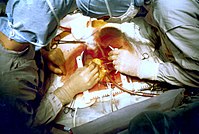
Photo from wikipedia
Background Chest tubes are routinely used after cardiac surgery to evacuate shed mediastinal blood. Incomplete chest drainage due to chest tube clogging can lead to retained blood after cardiac surgery.… Click to show full abstract
Background Chest tubes are routinely used after cardiac surgery to evacuate shed mediastinal blood. Incomplete chest drainage due to chest tube clogging can lead to retained blood after cardiac surgery. This can include cardiac tamponade, hemothorax, bloody effusions and postoperative atrial fibrillation (POAF). Prior published non randomized studies have demonstrated that active tube clearance (ATC) of chest tubes can reduce retained blood complications prompting the ERAS Cardiac Society guidelines to recommend this modality. Objective A randomized prospective trial to evaluate whether an ATC protocol aimed at improving chest tube patency without breaking the sterile field could efficiently reduce complications related to retained blood after cardiac surgery. Methods This was a pragmatic, single-blinded, parallel randomized control trial held from November 2015 to June 2017 including a 30-day post index surgery follow-up. The setting was two academic centers affiliated with the Université de Montréal School of Medicine; the Montreal Heart Institute and the Hôpital du Sacré-Coeur de Montréal . Adult patients admitted for non-emergent coronary bypass grafting and/or valvular heart surgery through median sternotomy, in sinus rhythm for a minimum of 30 days prior to the surgical intervention were eligible for inclusion. In the active tube clearance group (ATC), a 28F PleuraFlow device was positioned within the mediastinum. In the standard drainage group, a conventional chest tube (Teleflex Inc.) was used. Other chest tubes were left at the discretion of the operating surgeon. Results A total of 520 adult patients undergoing cardiac surgery were randomized to receive either ATC ( n = 257) or standard drainage ( n = 263). ATC was associated with a 72% reduction in re-exploration for bleeding (5.7% vs 1.6%, p = .01) and an 89% reduction in complete chest tube occlusion (2% vs 19%, p = .01). There was an 18% reduction in POAF between the ATC and control group that was not statistically significant (31% vs 38%, p = .08). Conclusions and relevance In this RCT, the implementation of active clearance of chest tubes reduced re-exploration and chest tube clogging in patients after cardiac surgery further supporting recommendations to consider this modality postoperatively. Trial registration Clinical Trials NCT02808897 . Retrospectively registered 22 June 2016.
Journal Title: Journal of Cardiothoracic Surgery
Year Published: 2021
Link to full text (if available)
Share on Social Media: Sign Up to like & get
recommendations!